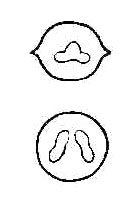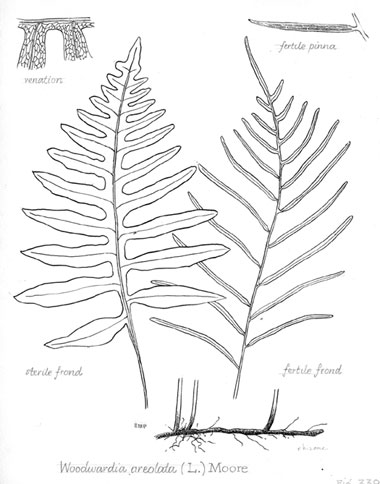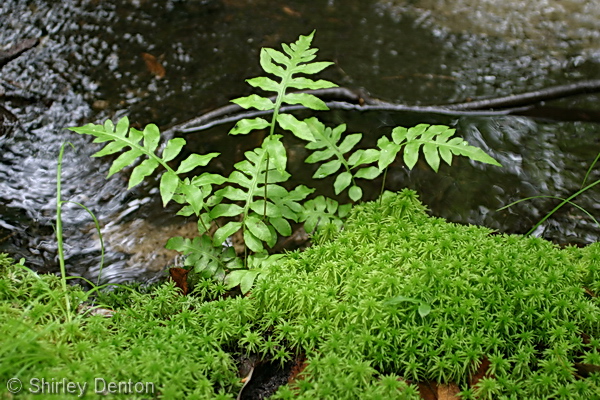|
Hardy Fern Home W. areolata resources
All Ferns � Blechnaceae �� Woodwardia
�Other Genera
|
| Woodwardia areolata | ||
Netted chain fern | ||
|
Etymology
Areolata means pitted.
Description
Rhizome: long-creeping, blackish, scales brown, dense.
Frond: 70 cm high by 20 cm wide, deciduous, dimorphic, sterile fronds 10 cm shorter, emerging first, fertile midsummer,, blade/stipe ratio: 1:1. Stipe: sterile: reddish brown below, straw-colored above; fertile: darker, to purple-black, sparsely set brown scales, vascular bundles: 2 elongate or peanut-shaped at stipe base, merging above to a tripartite structure. Blade: 1-pinnate fertile, sterile less divided above where it is winged along the rachis, lanceolate, thin-textured, bright green later, reddish on emergence, scaly-glandular upon emergence but soon glabrous. Pinnae: 7 to 12 pair, sterile alternate, lanceolate, fertile subopposite, contracted; margins minutely serrate to crenate; veins netted near the costa, free near the margin. Sori: in chainlike rows, sunken into the lamina, but distinct, along the costae, indusium: flap-like, tucked under sporangia, disintegrating with age, opening towards the costa, sporangia: reddish-brown, maturity: late summer to early fall. Culture
Habitat: acidic bogs, seeps, and wet woods, rarely on rock of siliceous cliffs and ledges on northern edge of range.
Distribution: coastal eastern North America and throughout southeastern North America.
Hardy to -35�C, USDA Zone 3.
Distinctive Characteristics
Superficial resemblance to Onoclea sensibilis, but distinguished by very different fertile fronds (linear sori vs. beads), sterile pinnae�simple with serrate�margins here while O. sensibilis has pinnatifid pinnae with entire margins�on the lower frond.
Synonyms
Acrostichum areolatum Linnaeus Lorinseria areolata (Linnaeus) C. Presl Woodwardia angustifolia J.E. Smith, invalid |
|
|
Notes
Dimorphism is sometimes incomplete, yielding a frond fertile at the top, sterile below.
Taxonomy Lorinseria areolata is still in play as a preferred name.
Dimorphism is sometimes incomplete, yielding a frond fertile at the top, sterile below.
Taxonomy Lorinseria areolata is still in play as a preferred name.

Woodwardia areolata. a) sterile and fertile fronds; b) chains of indusia; c) net venation. �Illustration by V. Fulford from Ferns and Fern Allies of Canada, William J. Cody and Donald M. Britton, 1989, � Agriculture Canada, used with permission. |

Woodwardia areolata. Two peanut-shaped vascular bundles at the base (below) merging into a tripartite structure at the top of the stipe. �Drawing from Ferns of Northeastern United States, Farida A. Wiley, 1936. |

Woodwardia areolata. �Illustration by Edgar Paulton, from How to Know the Ferns and Fern Allies, John T. Mickel, � 1979 Wm. C. Brown Co. |
